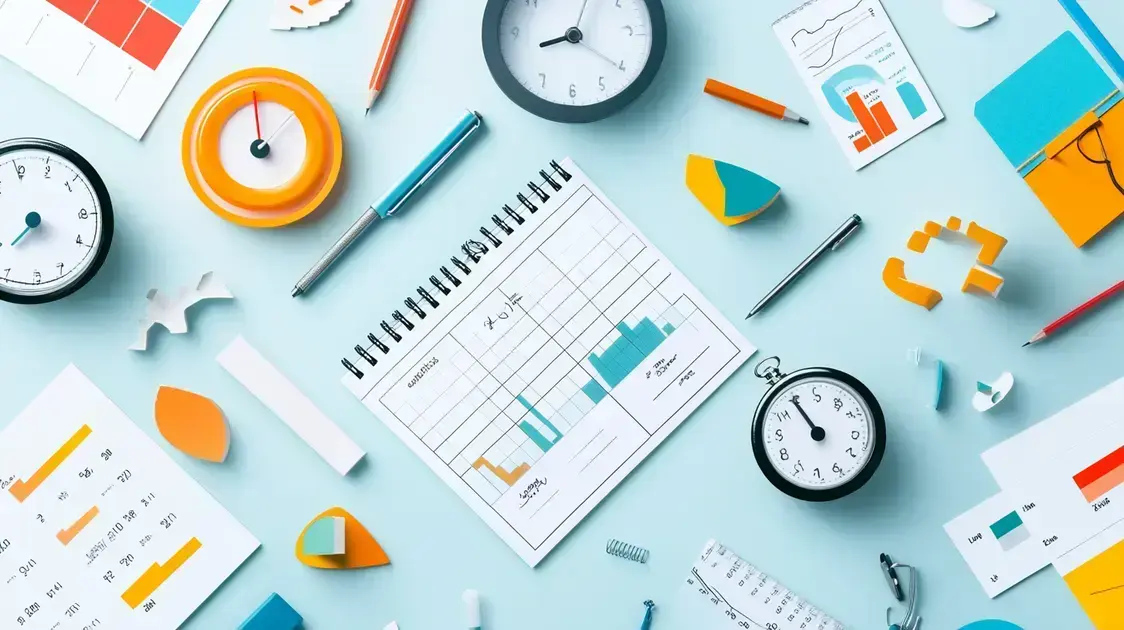In today’s fast-paced world, embracing productivity life hacks is crucial for optimizing efficiency. With increasing demands on time and energy, finding ways to work smarter rather than harder can make a significant difference. Small adjustments in daily routines can lead to greater focus and improved results.
Whether you’re a student, professional, or entrepreneur, mastering these strategies can help streamline tasks and maximize output. From time management techniques to minimizing distractions, incorporating the right habits can enhance overall performance and reduce stress.
Unlocking the power of productivity life hacks can transform the way you approach work and daily responsibilities. Keep reading to discover practical and effective tips that will help you boost efficiency and achieve more in less time.
Understanding Productivity Life Hacks
Understanding Productivity Life Hacks is the first step towards enhancing your daily efficiency. These hacks are small, practical tips or strategies that can significantly improve how you work and manage your time. They focus on eliminating waste, maximising resources, and creating effective routines that lead to better work outcomes.
What Are Productivity Life Hacks?
Productivity life hacks refer to clever shortcuts or techniques that help individuals optimise their time and tasks. They can vary from simple methods like the two-minute rule, where any task that takes less than two minutes should be done immediately, to more advanced strategies like the Pomodoro Technique, which uses timed intervals of focused work followed by short breaks.
The Importance of Productivity Life Hacks
In a world where time is a precious commodity, utilising these hacks allows us to get more done in less time. This means spending fewer hours on tasks while still achieving the same, if not better, results. Additionally, productivity hacks can help reduce stress and make work feel more manageable.
Key Principles Behind Effective Hacks
To make the most out of productivity life hacks, focus on a few key principles: planning, prioritisation, and consistency. Planning involves setting clear goals and determining what tasks are most critical. Prioritisation means figuring out which tasks yield the greatest results, allowing you to focus your efforts accordingly. Lastly, consistency is about routinely applying these hacks, making them a natural part of your work ethic.
How to Identify Productivity Life Hacks That Work for You
Not all hacks will work for everyone. It’s vital to experiment and discover which techniques suit your working style and responsibilities. Keeping a log of productivity practices you try, along with their outcomes, can help identify the most effective strategies for you.
Final Thoughts on Implementing Life Hacks
While productivity life hacks can yield impressive results, remember that true effectiveness stems from making sustainable lifestyle changes. Embracing a mindset focused on optimisation and routine will lead to long-term improvements in your daily efficiency.
Top 7 Productivity Life Hacks to Implement Today
Here are the top 7 productivity life hacks you can implement today to transform your efficiency:
1. The Two-Minute Rule
If a task will take less than two minutes, do it immediately. This prevents procrastination and keeps your to-do list manageable.
2. Time Blocking
Schedule specific blocks of time for different tasks throughout your day. This method helps to ensure you focus on one task at a time without distractions.
3. Use Checklists
Create daily or weekly checklists to keep your tasks organized. Checking off completed items provides a sense of accomplishment and motivation.
4. Limit Distractions
Identify distractions in your environment and work to remove them. Turn off notifications, close irrelevant tabs, and create a focused workspace wherever possible.
5. Take Regular Breaks
Using techniques like the Pomodoro Technique can help you maintain a balance between work and rest. After 25 minutes of focused work, take a 5-minute break to refresh your mind.
6. Declutter Your Workspace
A clean and organized workspace can boost productivity significantly. Spend a few minutes daily to tidy up your working area and eliminate unnecessary clutter.
7. Set Clear Goals
Establish specific, realistic goals for your day. Knowing what you need to achieve helps you stay focused and motivated throughout the day.
Tools to Enhance Your Productivity

To enhance your productivity, using the right tools can make a significant difference. Below are some essential tools to enhance your productivity:
1. Task Management Apps
Applications like Trello, Asana, and Todoist help you organise and manage tasks efficiently. They allow you to set deadlines, create checklists, and track progress, ensuring nothing falls through the cracks.
2. Time Tracking Software
Tools such as Toggl and Clockify help you monitor how you spend your time. They provide insights into your workflow, allowing you to identify patterns and areas for improvement.
3. Note-Taking Applications
Apps like Evernote or OneNote are great for jotting down ideas or important notes. They allow you to store information in an organised way, making it easy to retrieve when needed.
4. Focus Applications
If you struggle with distractions, consider using apps like Focus@Will or Forest. These tools provide background sounds or visual incentives to keep you concentrated on your work.
5. Communication Tools
Platforms like Slack or Microsoft Teams facilitate seamless communication within teams. Good communication reduces misunderstandings and helps keep everyone on the same page.
6. Pomodoro Timers
Using a Pomodoro timer can improve your focus and efficiency. This technique involves working for a set period, then taking a short break, which helps maintain high levels of concentration.
7. Cloud Storage Services
Services like Google Drive or Dropbox allow you to access your files from any device. They also make it easy to share documents and collaborate with others, leading to better productivity.
How to Prioritise Tasks Effectively
Prioritising tasks effectively is crucial for maximising productivity. Here are some strategies to help you manage your tasks:
1. List Your Tasks
Start by writing down all the tasks you need to complete. Having everything in one place helps you visualise your workload and makes it easier to assess what needs to be done.
2. Use the Eisenhower Matrix
The Eisenhower Matrix helps you categorise tasks based on urgency and importance. Divide tasks into four quadrants: urgent and important, important but not urgent, urgent but not important, and neither urgent nor important. Focus on what matters most.
3. Assign Deadlines
Set deadlines for each task. When tasks have clear due dates, it encourages you to allocate time effectively and keeps you accountable.
4. Focus on High-Impact Tasks
Identify tasks that will have the most significant impact on your goals. Concentrating on high-impact tasks ensures that you use your time where it counts most.
5. Review and Adjust
Regularly review your task list and priorities. Adjusting your plan based on changing circumstances ensures that you remain flexible and focused on the right things.
6. Delegate When Possible
If you have tasks that others can handle, delegate them. This frees up your time to focus on more critical responsibilities.
7. Limit Multitasking
Studies show that multitasking can reduce productivity. Focus on completing one task at a time before moving on to the next to ensure quality work.
Creating a Distraction-Free Work Environment
Creating a distraction-free work environment is essential for improving productivity. Here are some effective strategies to help you establish such an environment:
1. Organise Your Workspace
Keep your desk tidy and organised. A clean workspace reduces clutter and helps you focus on the task at hand. Use organisers and keep only the essentials on your desk.
2. Control Noise Levels
Reduce background noise by using noise-cancelling headphones or playing soft background music. If possible, find a quiet location to work or use white noise machines to create a more peaceful environment.
3. Set Clear Boundaries
Let others know when you’re working and ask them to respect your time. Consider using a “do not disturb” sign or setting specific hours for focused work when you won’t be interrupted.
4. Limit Digital Distractions
Turn off non-essential notifications on your phone and computer. Use apps like Freedom or Cold Turkey to block distracting websites during your work hours.
5. Establish a Routine
Creating a daily routine can help signal to your mind that it’s time to focus. Schedule specific blocks of time for work and breaks to build a productive rhythm.
6. Optimise Your Lighting
Ensure that your workspace has adequate lighting. Natural light is ideal, but if that’s not possible, use bright, warm lights that help to keep you alert and focused.
7. Use Personal Items Wisely
While personal items can make your workspace comfortable, too many can become a distraction. Choose a few meaningful items to personalise your space without cluttering it.
Time Management Techniques for Increased Productivity

Time management is essential for increasing productivity. Here are effective techniques to help you manage your time better:
1. Prioritisation Matrix
Use a prioritisation matrix to decide which tasks require your immediate attention. Categorising tasks into urgent versus important can help you focus on what truly matters.
2. The Pomodoro Technique
This technique involves working for 25 minutes and then taking a 5-minute break. After completing four cycles, take a longer break of 15–30 minutes. This method enhances focus and prevents burnout.
3. SMART Goals
Set SMART (Specific, Measurable, Achievable, Relevant, Time-bound) goals. This framework can clarify your targets and help you stay on track, making it easier to determine your daily priorities.
4. Block Scheduling
Allocate specific time blocks for different activities or tasks throughout your day. This creates a structured schedule, promotes focus, and reduces the chances of distractions.
5. Time Audits
Conduct regular time audits to evaluate how you spend your time. Identifying time-wasting habits or activities can help you make necessary adjustments and improve efficiency.
6. Use Alarms and Reminders
Set alarms and reminders to keep tasks on track. Whether it’s a timer for the Pomodoro Technique or alerts for upcoming meetings, these tools can help you stay organised and ensure you don’t miss deadlines.
7. Learn to Say No
Understand your limitations and learn to say no to tasks or commitments that don’t align with your priorities. This helps you protect your time and focus on what matters most.
Measuring Your Productivity Progress
Measuring your productivity progress is crucial for understanding how effectively you are working. Here are some strategies to help you track your productivity:
1. Set Clear Objectives
Establish specific goals for what you want to achieve. Clear objectives provide a benchmark to measure your progress and successes.
2. Use a Productivity Journal
Maintain a daily or weekly productivity journal to record your tasks, achievements, and challenges. This helps you reflect on your performance and identify areas for improvement.
3. Track Time Spent on Tasks
Use time tracking tools to log how much time you spend on different activities. Reviewing this data can reveal patterns and help you adjust your workload and focus.
4. Regular Progress Reviews
Schedule regular times to review your progress towards your goals. Weekly or monthly check-ins can help you stay aligned with your objectives and make necessary changes.
5. Set Milestones
Break larger projects into smaller milestones. Celebrating small achievements can motivate you and give you a clear sense of progression.
6. Seek Feedback
Asking for feedback from colleagues or supervisors can provide valuable insights into your productivity. Others might observe things you haven’t noticed.
7. Use Productivity Apps
Leverage productivity apps that allow you to set goals, track your progress, and analyse your performance. Many tools offer visual representations of your progress, making it easier to understand your productivity trends.
FAQ – Frequently Asked Questions about Productivity Life Hacks
What are productivity life hacks?
Productivity life hacks are clever strategies or shortcuts that help you work more efficiently and effectively, saving time and effort.
How can I implement productivity life hacks in my daily routine?
Start by choosing a few hacks that resonate with you, such as the two-minute rule or time blocking, and incorporate them into your daily tasks.
Why is measuring productivity progress important?
Measuring productivity progress helps you understand how effective your work habits are and identifies areas where you can improve.
What tools can help enhance my productivity?
Tools like task management apps, time tracking software, and focus applications can significantly enhance your productivity by keeping you organised and on task.
How can I create a distraction-free work environment?
To create a distraction-free work environment, organise your workspace, control noise levels, and limit digital distractions.
What time management techniques can I use for increased productivity?
Techniques such as the Pomodoro Technique, prioritisation matrix, and block scheduling are effective for managing time and increasing productivity.
Check out our article on Recycling Techniques to explore innovative methods for reducing waste and promoting sustainability.
